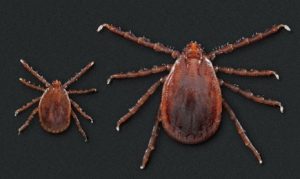An adult lone star tick in central Delaware. DNREC photo.
With spring heading into summer – prime time for ticks as well as for people getting outdoors – the Delaware Department of Natural Resources and Environmental Control (DNREC) has partnered with the Division of Public Health within the Delaware Department of Health and Social Services (DHSS) to educate the public about ticks, including where they are found, how to identify different types and what precautions to take before and after exposure to ticks, as well as information about tick-borne pathogens.
“Summer in Delaware is a great time to be outdoors enjoying Delaware’s state parks, wildlife areas, trails and waters,” said DNREC Secretary Shawn M. Garvin. “However, time-honored summer activities like hiking, biking, fishing and even beachgoing and gardening can expose outdoor enthusiasts to unwanted guests – ticks. The good news is residents and visitors can take steps such as using repellent, wearing light-colored clothes and checking for ticks after being outdoors to reduce or prevent the chances of getting tick bites.”
“We encourage Delawareans to get outside to enjoy fitness and family time,” said DHSS Secretary Molly Magarik. “But we also urge people to take the proper precautions to protect themselves and others because tick bites can cause serious illness. In Delaware, the most common tick-borne illness is Lyme disease. Symptoms can include a ‘bull’s-eye’ rash (seen in approximately half of Lyme disease cases in Delaware), fever, fatigue, headache, and muscle and joint aches. Chronic joint, heart, and neurological problems may occur. We urge anyone bitten by a tick to monitor their health closely, and contact a physician if symptoms develop.”
Precautions to avoid or reduce tick exposure include:
- Keep grass short and remove brush from the yard to reduce tick habitat.

Long pants tucked into socks can help prevent tick exposure. DNREC photo. - Wear long sleeves and long pants tucked into socks and use repellent to help keep ticks off in areas with high tick populations.
- Choose light colored clothing to make ticks easier to see.
- When returning from outdoor activities, check for ticks and remove any from skin with tweezers as soon as possible to reduce the chance of disease transmission.
- Following exposure to tick-prone areas or tick bites, watch for symptoms of common illnesses caused by tick-borne pathogens and seek medical attention as needed.
The DNREC Division of Fish and Wildlife and the DHSS Division of Public Health work together year-round to study tick populations, species distribution, seasonality and disease risk to humans, including Lyme disease. The goal of the tick program is to better understand the biology and ecology of Delaware ticks and the problems they cause, including how to best cope with those problems.

For DNREC Tick Program entomologist Dr. Ashley Kennedy, part of that work includes statewide tick surveys to collect and identify types of ticks.
“Tick surveys provide information about the numbers and species of ticks found in Delaware, as well as information about tick-borne diseases, since certain diseases are associated with certain tick species,” said Dr. Kennedy. “Knowing what species of tick has attached to you, a family member, or a pet will help determine whether you may be at risk for a tick-borne disease.”
To help Delaware residents and visitors exposed to ticks, DNREC has launched a new online tick interactions form that asks when and where the interaction took place, contact information and a photo of the tick if available to help identify its species.
Read more about Dr. Kennedy’s work in “Tick-Tock – the Ticks Are Waiting” in Outdoor Delaware online magazine.
Other tick facts include:
- In Delaware, ticks are everywhere, but most bites occur in backyards.
- Ticks do not jump or fall out of trees; they wait on grass or other plants for a host to walk by so they can grab on.
- Ticks are active year-round, not just in late spring/early summer which is prime “tick season.”
- Several different types of ticks are found in Delaware, and several types can carry different pathogens that can infect humans including Lyme disease.
More information about ticks can be found at de.gov/ticks and de.gov/lyme.
About DNREC
The Delaware Department of Natural Resources and Environmental Control protects and manages the state’s natural resources, protects public health, provides outdoor recreational opportunities, and educates Delawareans about the environment. The DNREC Division of Fish and Wildlife conserves and manages Delaware’s fish and wildlife and their habitats, and provides fishing, hunting, wildlife viewing and boating access on nearly 68,000 acres of public land. For more information, visit the website and connect with @DelawareDNREC on Facebook, Twitter or LinkedIn.
Media Contacts: Joanna Wilson, joanna.wilson@delaware.gov; Michael Globetti, michael.globetti@delaware.gov

